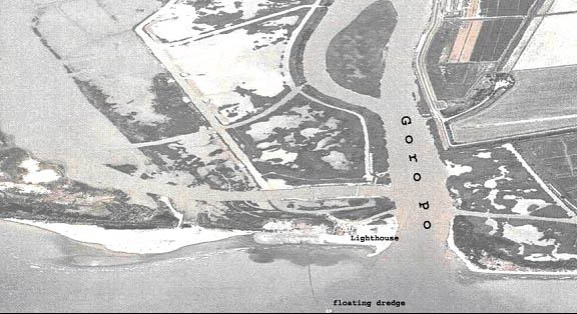| Goro mouth – Po delta - Italy |
| Complete description
of case study |
PHOTO OF THE SITE
 |
|
CASE STUDY
| Title | Goro mouth – Po delta |
| National level | Italy |
| Regional level | Veneto and Emilia Romagna Regions |
| Local level | Rovigo and Ferrara Provinces |
ABSTRACT
|
The examined area is located in the right side of the Goro Po mouth. This is a deltaic littoral area, mainly characterized by bars sometimes related to wide spits evolution, that edge large inner land lagoons with high anthropic pressure. Nowadays, in Goro Po area, a sandy beach edged by coastal dunes ridges and submerged bars on the bottom are present. The physical processes induce a longshore transport connected to Sirocco and Levanter winds; the other winds have less importance for the protection offered by Po Delta apparatus prominence. The sedimentary supply for the Goro spit are mainly due to Goro Po river contribute and, partially, comes from reworked sediments coming from northern beaches with a transportation average about of 180 millions m3 every year. From 1975 to 1980, 1.3 million m3 of sandy sediments was brought to the sea from Goro Po. Only partly these sediments supply the Goro spit growth because most part of these are dispersed on the bottom and trapped, by mouths, in the backward lagoon. In the last tens years 8 million m3 of sediments have nourished the sea bottom in front of Goro spit, but great part of these counterbalance the local natural and human induced subsidence. Former researches (Bondesan e Simeoni, 1983) show that from 1900 to 1957 , the Goro area lowers in a differentiate way about 8mm/yr. To the natural subsidence, after 1938, the human induced subsidence adds up. The lowering rate, after this time, in fact highly raises, mainly in the period 1951-1962. The Goro Po mouth shows an highly asymmetric morphology: an erosional trend of the mouth right side and an advancing trend or steadiness of left side, that also presents, in the in front sea bottom, a well developed submerged bar system (Del Grande and Tessari, 2000). The most important activities of this area are referred to fishery that, from ‘80 years, became the main profit for the inhabitants, after the introduction of breeding of clams (Tapes philipinarum) inside the lagoon, and of mussels in the in front sea. Many policies
concur to sustain the maintenance of this area: the regional policy (Environment
Councillorship- Soil and coasts Defense) aims to safe the areas, when
populated or industrial activities could be damaged by natural hazards.
Po Delta Natural Regional Park policy is to keep relevant natural areas
and, when possible, to restore the natural value of damaged areas, mainly
trough eco-compatible actions. The Goro Municipality and the Ferrara Province
policies aim to safe the economic activities and the natural value of
this land. |
BASIC INFORMATION
| Coastal characteristics |
|
| Policy options | Limited intervention, hold the line |
| Socio-economic activities | Tourism, fishery, nature conservation |
| Engineering techniques | Nourishment, groyne, revetment, dune rebuilding |
SOURCE
| Name | Umberto Simeoni |
| Institution | Dept. of Earth Sciences, Ferrara University |
| Address | Corso
Ercole I d’Este, 32 I-44100 Ferrara (Italy) |
| Telephone / fax | +39 053 2293723 / +39 053 2206468 |
| g23@unife.it |